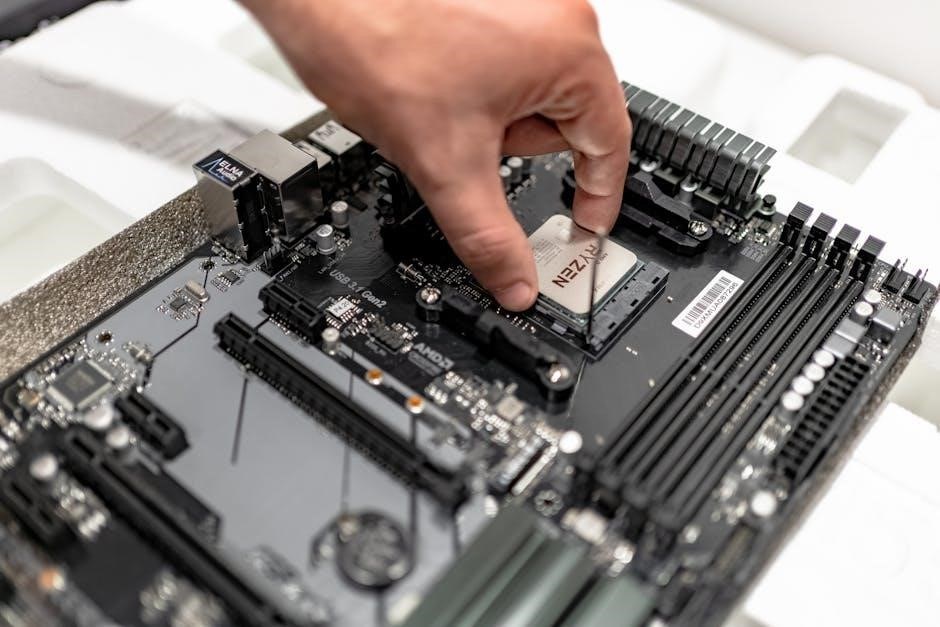The GE Nautilus Dishwasher is a reliable and efficient appliance designed for household use, offering convenient dishwashing solutions. This manual provides essential guidance for optimal performance and user experience.
1.1 Overview of the GE Nautilus Dishwasher
The GE Nautilus GSC3400GWW is a built-in dishwasher designed for household use, offering efficient cleaning for dishes, silverware, and utensils. With a focus on convenience and performance, it features multiple wash cycles and quiet operation. Its large capacity and user-friendly controls make it an ideal choice for modern kitchens, ensuring clean and hygienic results while maintaining energy efficiency.
1.2 Importance of the Instruction Manual
The instruction manual is essential for understanding the GE Nautilus Dishwasher’s features, operation, and maintenance. It provides detailed guidance on installation, safety precautions, and troubleshooting, ensuring optimal performance and longevity. By following the manual, users can avoid common issues, use the dishwasher safely, and maintain its efficiency, making it a crucial resource for both new and experienced users.

Key Features and Specifications
The instruction manual is essential for understanding the GE Nautilus Dishwasher’s features, operation, and maintenance. It provides detailed guidance on installation, safety precautions, and troubleshooting, ensuring optimal performance and longevity. By following the manual, users can avoid common issues, use the dishwasher safely, and maintain its efficiency, making it a crucial resource for both new and experienced users.
2.1 Product Specifications of the GE Nautilus GSC3400GWW
The GE Nautilus GSC3400GWW is a built-in dishwasher designed for household use, offering a 24-inch width and quiet operation. It features a stainless steel tub, multiple wash cycles, and Energy Star certification. The dishwasher includes adjustable racks, a quiet operation mode, and compatibility with various accessories. Its efficient design ensures optimal cleaning while minimizing water and energy usage.
2.2 Main Features of the Dishwasher
The GE Nautilus GSC3400GWW dishwasher features adjustable racks for flexible loading, quiet operation, and multiple wash cycles for tailored cleaning. It includes a stainless steel tub for durability and hygiene, along with drying options like heated drying and fan drying. Energy-efficient design and compatibility with approved detergents ensure optimal performance while minimizing water and energy consumption, making it a practical choice for modern households.
2.3 Compatible Accessories and Installation Kits
The GE Nautilus GSC3400GWW dishwasher is compatible with various accessories, including the Universal Dishwasher Connector Kit (PM28X326) and Installation Kit (PM28X329). Additionally, a 7′ Dishwasher Power Cord (WX09X70911) is available for installation. These kits ensure proper installation and function, enhancing the dishwasher’s performance. They are designed to meet specific requirements and are available for purchase to complement your appliance.

Installation Instructions
Ensure proper installation by following the provided guidelines, including positioning the dishwasher correctly and connecting water and power supplies safely. Refer to the manual for detailed steps.
3.1 Proper Installation Requirements
Proper installation ensures safe and efficient operation. Position the dishwasher levelly, secure it to adjacent cabinets, and connect the drain hose to a garbage disposal or sink drain. Use the provided installation kit, ensuring all water and electrical connections are secure. Verify ventilation requirements and adhere to local plumbing and electrical codes. Follow the manual’s detailed guidelines for a trouble-free setup.
3.2 Step-by-Step Installation Guide
Begin by positioning the dishwasher in front of the cabinet opening. Insert the drain hose into the designated hole in the cabinet side. If using a power cord, guide it through a separate opening. Secure the appliance to adjacent cabinets to prevent movement. Tighten all water supply lines and electrical connections. Ensure compliance with local plumbing and electrical codes. Refer to the manual for specific instructions and safety guidelines.

Safety Precautions
Always follow safety guidelines to avoid accidents. Clean filters regularly, check for blockages, and use approved detergents. Ensure proper installation before use.
4.1 General Safety Guidelines
Read the manual carefully before using the dishwasher. Avoid hot surfaces and keep children away. Ensure proper installation and leveling to prevent leaks or damage. Use only recommended detergents and follow dosage instructions. Regularly clean filters and check for blockages. Never operate the dishwasher with damaged parts or malfunctioning controls. Always unplug during maintenance to ensure safety.
4.2 Safety Tips for Operation and Maintenance
Regularly clean filters and spray arms to ensure proper water flow. Run cleaning cycles periodically to remove grease and food residue. Use only approved detergents to avoid suds buildup. Check for blockages in the drain hose and ensure proper installation. Avoid overloading the dishwasher to maintain balance and prevent leaks. Always follow recommended maintenance schedules for optimal performance and safety.

User Manual Overview
The GE Nautilus Dishwasher manual provides detailed instructions for installation, operation, and maintenance. It includes troubleshooting tips and warranty information to ensure optimal performance and user satisfaction.
5.1 Navigating the GE Nautilus Dishwasher Manual
The GE Nautilus Dishwasher manual is structured to guide users through installation, operation, and maintenance. It includes sections on product specifications, safety guidelines, and troubleshooting. The manual is available in PDF format and can be downloaded from GE’s official website. Clear indexing and detailed instructions ensure easy navigation, helping users quickly find relevant information for optimal dishwasher performance and care.
5.2 Understanding the Control Panel and Settings
The GE Nautilus Dishwasher features an intuitive control panel with buttons and an LED display for easy operation. Users can select from various wash cycles, including light, normal, and heavy-duty options. Additional settings like heat boost and delay start enhance customization. The manual provides detailed explanations of each button and cycle, ensuring users can optimize their dishwashing experience with minimal effort;
Loading the Dishwasher
Proper loading ensures efficient cleaning and hygiene. Arrange dishes facing the center, with larger items at the bottom and utensils in designated racks for optimal results.
6.1 Proper Loading Techniques
Place dishes facing the center with larger items at the bottom for optimal water flow. Utensils should be secured in designated racks, and fragile items positioned carefully. Avoid overcrowding to ensure effective cleaning. Proper arrangement prevents damage and ensures all items are thoroughly cleaned. Follow these techniques for efficient and hygienic dishwashing results every cycle.
6.2 Optimizing Dishwasher Capacity
Maximize space by arranging dishes according to size and type. Use adjustable racks to accommodate larger items. Place utensils in designated holders to free up space. Avoid overcrowding to ensure proper water circulation. Efficient loading ensures all items are cleaned thoroughly while maintaining energy efficiency. This approach optimizes performance and extends the lifespan of your GE Nautilus Dishwasher.
Cycle and Option Settings
The GE Nautilus dishwasher offers multiple wash cycles, including Heavy Duty and Normal, with options like Heated Dry and Delay Start for customized cleaning and convenience.
7.1 Available Wash Cycles and Options
The GE Nautilus dishwasher features multiple wash cycles, including Heavy Duty, Normal, and Light/China, tailored for different load types. Additional options like Heated Dry, Delay Start, and Sanitize provide enhanced cleaning and convenience. These settings allow users to customize wash performance based on soil levels and dish material, ensuring optimal results while maintaining energy efficiency and gentle care for delicate items.
7.2 Customizing Wash Settings for Best Results
For optimal performance, users can tailor wash cycles by selecting specific options like Heated Dry or Delay Start. Adjusting settings based on load size and soil level ensures efficient cleaning. Combining cycles with options such as Sanitize or Light/China modes enhances results. Customization allows for personalized cleaning, balancing effectiveness and energy usage, ensuring dishes are spotless while maintaining gentle care for delicate items.
Maintenance and Troubleshooting
Regularly clean filters and spray arms to ensure optimal performance. Address common issues like standing water or noise by checking for blockages and running cleaning cycles.
8.1 Regular Maintenance Tips
Regular maintenance ensures optimal performance. Clean filters and spray arms to remove debris. Check and clean door seals to prevent leaks. Run cleaning cycles with dishwasher cleaners to eliminate grease and odors. Ensure drain hoses are clear and kink-free for proper water flow. Regularly inspect and replace worn-out parts to maintain efficiency and longevity of your GE Nautilus dishwasher.
8.2 Common Issues and Solutions
Common issues with the GE Nautilus dishwasher include water standing in the bottom, poor cleaning performance, and noise during operation. Solutions include cleaning the drain filter, checking for blockages in spray arms, and ensuring proper detergent dosage. For noise, inspect for loose items or improper leveling. Regular maintenance and adhering to the manual’s guidelines can prevent these issues and ensure smooth operation.
Detergent Usage
Use Cascade Automatic Dishwashing Detergent for optimal cleaning. Follow recommended dosage to prevent excess suds. Proper application ensures efficiency and minimizes maintenance. Consult the manual for specific guidelines for best results.
9.1 Recommended Dishwashing Detergents
Cascade Automatic Dishwashing Detergent is approved for use in GE Nautilus dishwashers, ensuring effective cleaning and preventing excess suds. It is designed to dissolve food residue thoroughly and leave dishes sparkling clean. Proper dosage is essential to avoid over-sudsing, which can affect performance. Always follow the recommended amount specified in the manual for optimal results and to maintain your dishwasher’s efficiency.
9.2 Proper Detergent Dosage and Application
For optimal performance, use the recommended dosage of Cascade Automatic Dishwashing Detergent. Exceeding the suggested amount can cause excess suds, affecting the dishwasher’s efficiency. Place the detergent in the designated dispenser, ensuring it is dry and free from obstructions. For best results, avoid overfilling and use pre-measured packets to maintain the correct dosage levels.

Energy Efficiency and Savings
The GE Nautilus dishwasher features energy-efficient cycles, including Heavy Duty and Normal settings, designed to minimize energy consumption while delivering superior cleaning performance.
10.1 Energy-Saving Features of the GE Nautilus
The GE Nautilus dishwasher incorporates advanced energy-saving features, including multiple efficient wash cycles and low water consumption settings. It is designed to meet ENERGY STAR standards, ensuring reduced energy usage. The dishwasher also offers a quiet operation and optimized settings that balance cleaning performance with energy efficiency, making it an eco-friendly choice for households.
10.2 Tips for Energy-Efficient Dishwasher Use
For energy-efficient use, run full loads to minimize cycles and water consumption. Use the energy-saving cycle for lightly soiled dishes. Avoid unnecessary pre-rinsing, as this wastes water and energy. Regularly clean filters and check spray arms to ensure optimal performance. Allow dishes to air-dry instead of using heat drying. Proper detergent dosage also helps maintain efficiency and reduces energy waste.

Common Problems and FAQs
Common issues include water standing in the dishwasher, excessive suds, and detergent not dispensing properly. FAQs address troubleshooting, maintenance, and optimal detergent usage for better performance.
11.1 Frequently Asked Questions
Common questions include why water remains in the dishwasher, how to remove excessive suds, and issues with detergent not dispensing. Users also ask about troubleshooting, maintenance tips, and optimal detergent usage. Additional FAQs cover cycle selections, noise levels, and error codes. For detailed solutions, refer to the manual or contact GE customer support for assistance.
11.2 Addressing Common User Concerns
Common concerns include water standing in the dishwasher, excessive suds, and detergent not dispensing. Solutions involve cleaning filters, checking detergent dosage, and ensuring proper installation. For issues like error codes or noise, refer to the manual or contact GE support. Regular maintenance, such as cleaning spray arms and running cleaning cycles, helps prevent many problems and ensures optimal performance.
Customer Support and Resources
GE Appliances offers comprehensive customer support through their website and toll-free hotline (1-800-626-2005). Additional resources, including manuals, FAQs, and troubleshooting guides, are available online for user convenience.
12.1 Accessing GE Customer Service
For assistance with your GE Nautilus Dishwasher, visit the official GE Appliances website or call their toll-free hotline at 1-800-626-2005. Online resources include user manuals, FAQs, and troubleshooting guides. Additionally, GE offers live chat support and a comprehensive service center locator to address any concerns or schedule maintenance. Their customer service team is available to provide guidance and resolve issues efficiently.
12.2 Additional Resources for Dishwasher Owners
GE Appliances offers extensive resources for Nautilus dishwasher owners, including downloadable user manuals, installation guides, and troubleshooting tips on their official website. The GE Answer Center provides direct support via phone or email. Additional resources include repair clinics, authorized service providers, and online forums where users can share experiences and solutions, ensuring comprehensive support for optimal dishwasher performance and maintenance.
By following the GE Nautilus Dishwasher manual, users can ensure optimal performance, longevity, and reliability. Proper usage and maintenance will enhance cleaning efficiency and overall satisfaction.
13.1 Final Tips for Optimal Dishwasher Performance
For optimal performance, ensure proper installation, regular maintenance, and correct detergent usage. Clean filters, check spray arms, and run cleaning cycles. Load dishes correctly, avoiding blockages. Use recommended detergents and follow guidelines. Address issues promptly to prevent long-term damage. Refer to the manual for specific care instructions and troubleshooting tips to maintain efficiency and extend the lifespan of your GE Nautilus Dishwasher.

























































